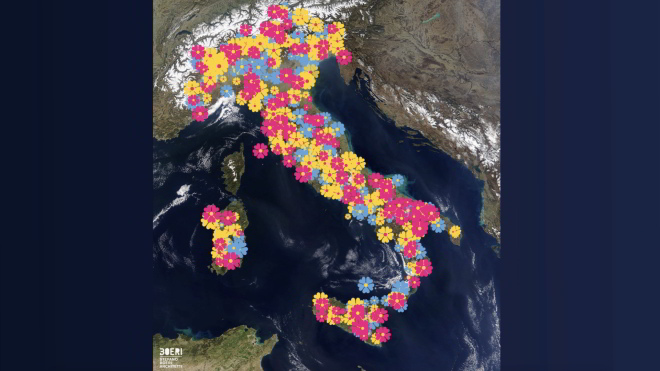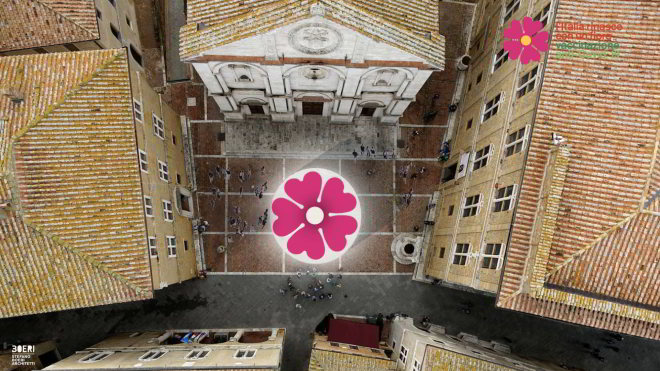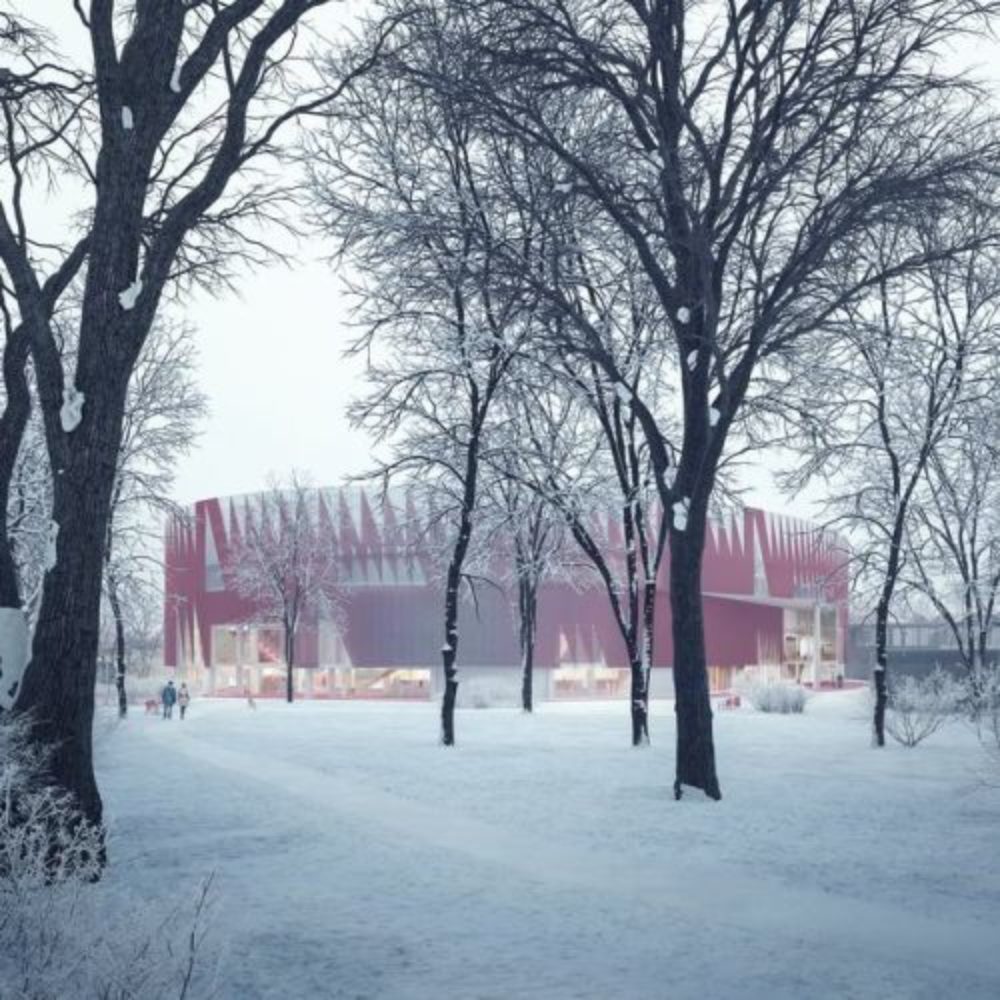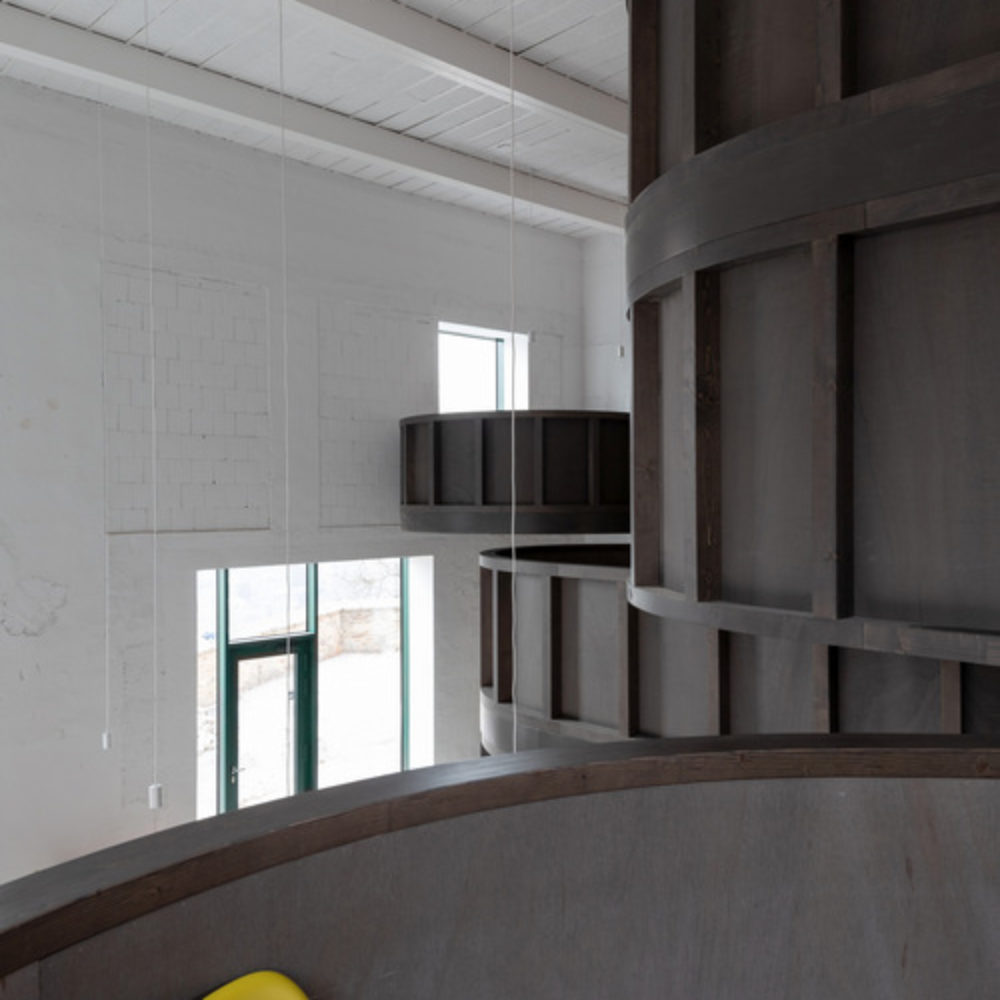Stefano Boeri präsentiert ein Konzept für die COVID-19-Impfungen. Kernstück ist ein Pop-up-Pavillon aus Holz und Textilien mit floralem Motiv. Stehen soll er auf jedem wichtigen Platz Italiens.
27. Dezember 2020 | Özlem Özdemir
A
llein die Namen seiner Projekte verraten es: Liuzhou Forest City, Pallazo Verde, Prato Urban Jungle. Er ist ein Pflanzennarr, der italienische Architekt Stefano Boeri. Zwei seiner Werke seien hervorgehoben: Bosco Verticale, ein begrünter Zwillingsturm in Mailand (2014) und das landmark-artige La Radura della Memoria (2020) zu Füßen der neuen Brücke von Genua, der Nachfolgerin der eingestürzten Ponte Morandi. Woran man sieht: Boeri ist erfahren in Sachen alarmierende Zustände wie städtische Luftverschmutzung und andere tragische urbane Themen. Auch wenn es in Mailand und Genua auf den ersten Blick nicht zu sehen ist: Sein neuestes Konzept für die Impfkampagne gegen Covid-19 hat (wie sich zeigen wird) von beidem etwas.
Wie kam es zu dem ungewöhnlichen Auftrag? Italiens Sonderkommissar für den Covid-19-Notstand, Domenico Arcuri, hatte den Wunsch nach einem nicht nur durchdachten, sondern auch ansprechenden Feldzug gegen die Pandemie. Erfüllt wird er nun – unentgeltlich – von Boeri und einem Beraterteam.
An vorderster Front des Gesamtkonzepts steht das Kampagnenlogo: ein einprägsames Blütenmotiv (dazu später mehr). Kern des Entwurfspakets sind temporäre Pavillons, worin sich die Einwohner auf den wichtigsten italienischen Plätzen impfen lassen können. Und schließlich bietet der Vorschlag von Boeri auch mobile Informationswände für öffentliche Plätze. Diese sollen die Bevölkerung dazu einladen, mehr über den Impfstoff und die Bedeutung der Impfung zu erfahren.
Zur Konstruktion und zu den Materialien: Der runde Pavillon mit dem großen Blumenlogo auf dem flachen Dach und anderen Stellen ist in Leichtbauweise konstruiert. Die Hauptelemente sind Holzrahmen und Stoff, die man leicht demontieren und wieder aufbauen kann. Zuunterst gibt es einen vorgefertigten Sockel, der ebenfalls aus Holz ist. Er unterstützt gleichzeitig das technische System für die Innenräume. (Parallel dazu wird das Dach zur Energieversorgung genutzt: mithilfe von Fotovoltaik-Paneelen.) Der tragende Rahmen ist aus Konstruktionsholz; die textile Außenverkleidung besteht aus recycelbaren, biologisch abbaubaren und wasserfesten Naturmaterialien. Ein weiteres charakteristisches Element sind die Trennwände der Innenräume; sie sind aus vorgefertigten Textilsystemen hergestellt, haben ein geringes Gewicht und sorgen für Flexibilität, Schallabsorption und Transparenz.


Die innere Organisation des Pavillons spiegelt das Blumen-Logo wieder; es gibt sowohl ein punktförmiges Zentrum als auch strahlenartig angelegte Fächer. Ersteres ist vorgesehen für die Verwaltung, Lager, Umkleideräume, spezielle Toiletten usw. Zweitere umfassen die Räume sowohl für die Verabreichung des Impfstoffs als auch jene für die Patientenaufnahme und das Warten nach der Impfung.
Besondere Aufmerksamkeit verdient die Blüte. Das Projekt zur Impfkampagne erhebt sie – und ihre grafische Darstellung und botanischen Prozesse – zur Metapher. Sie ist das, was sich öffnet, anlockt und sammelt und schließlich verteilt. Der Gesellschaft wird diese Botschaft nicht entgehen: Sie ist geplagt, sowohl von der Ausbreitung des Coronavirus als auch von der allgemeinen „Impfsehnsucht“, der großen Erwartung eines Vakzins.
Die Art, wie sich diese Blüte und damit das Projekt ausbreitet über das ganze Land (als wäre es eine einzige Wiese) ist verwurzelt im Werk des Architekten. Denn vom Bosco Verticale – bei dem verschiedenste Baumsorten auf den Balkonen eines Wohnturms wachsen – hat es das Übersäte, Verstreute, fast Überwuchernde. Von La Radura della Memoria hat es die Geometrie und Komposition: das Kreisförmige und Zentrierte und damit das Emblematische. Bei diesem Ort des Gedenkens stehen einzelne Bäume im Kreis, unter dem Ende des neuen Brückenbaus von Renzo Piano, dort also, wo vorher eine Brücke eingestürzt war und für viel Leid gesorgt hatte. Von La Radura geht eine feierliche Stimmung aus, ein Sinn für das Zusammensein und die Gemeinschaft. Und genau das bietet auch der Impf-Pavillon: Seine Form ist kreisrund, seine Funktion ist sozial.
Bosco Verticale geht gegen Luftverschmutzung an, La Radura gegen Verzweiflung, Trauer und Angst. All das fällt nun zusammen in einer rund angelegten, abstrakt-symmetrischen Blüte mit herzförmigen Blättern. So dekorativ das Impfkampagnen-Projekt von Boeri anmutet: Auch dieser Entwurf manifestiert eine Art von Kampf. Nur diesmal geht es um die Überwindung eines Krankheitserregers, die die Weltbevölkerung in traumatische Zustände versetzt hat. Der Architekt tut das auf bemerkenswerte Weise: Es ist, als würde der lebensgefährdende Übeltäter unter seinen Händen zu einer harmlos-hübschen Blume mutieren. Denn aufgrund ihrer Farbe, ihrer kreisförmigen Anordnung und ihren Kronblättern beschwört sie eine Assoziation: Sie erinnert an das meist rot dargestellte, mit Kronenzacken bestückte kugelige Spike-Protein, genannt Coronavirus. Diese florale Grafik ist daher fast etwas gewagt. Und doch: Die Transformation gleicht einem Triumph.
Die inspirierende Blume hinter dem Konzept ist die Primel. Damit wählte das Entwurfsteam ganz bewusst eine solche Art aus, die als erste nach einem langen Winter blüht und für das Wiedererwachen der Natur, den Frühling und den Neubeginn steht. Stefano Boeri sagt dazu: „Mit dem Bild einer Frühlingsblume wollten wir eine Architektur schaffen, die ein Symbol der Heiterkeit und Erneuerung vermittelt“.
Italien leitet mit diesem Projekt das erste Stadium der Post-Pandemie ein. Es ist Zeit, dass die Depression versiegt, es ist Zeit für Leichtigkeit und – passend und pünktlich zum Jahreswechsel – für Zuversicht. „Mit einer Blume erwacht Italien wieder zum Leben“ – so lautet der Slogan der Kampagne, das ist die unübersehbare frohe Kunde. Wobei diese Unübersehbarkeit am ehesten aus der Vogel- oder Satellitenperspektive zu genießen ist. Denn: Das sprießende, feuerwerkartige „Blumenmeer“, die quasi explosive Ausbreitung des Mittels gegen die ebenso explosive Ansteckungskraft von Corona kommt erst aus der Ferne zur Geltung. (Diametral entgegengesetzt zu dem, was es bekämpft, das Virus, das nur aus nächster Nähe – unter dem Elektronenmikroskop – wahrnehmbar ist.)



Ob Piazza del Campo in Siena, Piazza del Duomo in Mailand oder Piazza del Plebiscito in Neapel: So wie die Menschen ihre Injektion erhalten, erhalten die Plätze ihren Boeri-Stempel. Wo mancherorts für Massenimpfungen nur pure Funktionalität in Frage zu kommen scheint, wenn möglich in den Randzonen der Stadt (im Flair einer Messehallen-Raumökonomie), geht Italien einen anderen, einen (wen wundert es) ästhetischeren Weg. Das Land baut statt auf den klaustrophobischen Kabinen- oder Container-Look, statt auf labyrinthhafte Abteilungen auf die luftige und menschennahe Pavillon-Kultur, die ohnehin besser zum Südländischen passt. Diese Impfung ist integriert, ist ein alltäglicher Bestandtteil wie ein Coffee-to-go. Das Motto: ein fröhliches und lebensbejahendes „Design First“. ♦

Zur Website von
Stefano Boeri Architetti
Primrose versus pandemic
Italy’s post-pandemic times can begin. Stefano Boeri presents a concept for the COVID-19 vaccinations. The centrepiece is a pop-up pavilion made of wood and textiles with a floral motif. It is to stand in every relevant square.
The names of his projects alone give it away: Liuzhou Forest City, Pallazo Verde, Prato Urban Jungle. He is a plant nut, the Italian architect Stefano Boeri. Two of his works are worth highlighting: Bosco Verticale, a green twin tower in Milan (2014) and the landmark-like La Radura della Memoria (2020) at the foot of Genoa’s new bridge, the successor to the collapsed Ponte Morandi. Which goes to show: Boeri has experiences in disquieting conditions like urban air pollution and other tragic urban issues. Even if it is not visible at first glance in Milan and Genoa: his latest concept for the vaccination campaign against Covid-19 has (as will become apparent) a little of both.
How did the unusual assignment come about? Italy’s Special Commissioner for the Covid-19 emergency, Domenico Arcuri, had the wish for a campaign against the pandemic that was not only well-thought-out but also appealing. It is now being fulfilled – free of charge – by Boeri and a team of advisors.
At the forefront of the overall concept is the campaign logo: a catchy flower motif (more on this later). At the core of the design-package are temporary pavilions in which residents can get vaccinated in the most important Italian squares. Finally, Boeri’s proposal also offers mobile information totems for public squares. These will invite the population to learn more about the vaccine and the importance of vaccination.
On the construction and the materials: the round pavilion with the large flower logo on the flat roof and other parts is a lightweight construction. The main elements are wooden frames and fabric that can be easily dismantled and reassembled. At the bottom, there is a prefabricated wooden base. It also supports the technical system for the interior. (In parallel, the roof serves as energy supply: using photovoltaic panels.) The load-bearing frame consists of structural wood; the textile exterior cladding includes recyclable, biodegradable and waterproof natural materials. Another characteristic element consists of the partition-walls of the interior spaces; they are made of prefabricated textile systems, have a low weight and provide flexibility, sound absorption and transparency.
The internal organisation of the pavilion reflects the floral logo. It has both a point-like centre and ray-like compartments. The former is for administration, storage, changing rooms, toilets specifically for this purpose, etc. The latter include the rooms for the vaccine injection and those for patient reception and post-vaccination waiting.
The flower deserves special attention. The vaccination campaign project elevates it – and its graphic representation and botanical processes – to a metaphor. It is what opens, attracts and gathers, and finally distributes. Society will not miss this message: it is plagued, both by the spread of the coronavirus and by the general „vaccination craving“, the great expectation of a vaccine.
The way this blossom (and with it the project) spreads over the whole land (as if it were a single meadow) is rooted in the architect’s work. From Bosco Verticale – in which the most diverse varieties of trees grow on the balconies of a residential tower – it has the overgrown, scattered, almost overgrowing. From La Radura della Memoria it has geometry and composition: the circular and centred, thus the emblematic. At this place of commemoration, individual trees stand in a circle, under the end of Renzo Piano’s new bridge construction, that is, where a bridge had previously collapsed and caused much suffering. A solemn mood emanates from La Radura, a sense of togetherness and community. And this is what the vaccination pavilion also offers: its shape is circular, its function is social.
Bosco Verticale tackles air pollution, La Radura despair, grief and fear. All this now comes together in a round, abstract-symmetrical flower with heart-shaped leaves. As decorative as Boeri’s vaccination campaign project seems, this design also manifests a kind of fight. Only this time, it’s about overcoming a germ that has sent the world’s population into traumatic states. The architect does this in a remarkable way: it is as if the life-threatening culprit mutates into an innocuous-pretty flower under his hands. For due to its colour, its circular arrangement, its corolla leaves, it conjures up an association. It brings to mind the spherical spike protein, usually depicted in red, with crown jags, called coronavirus. Therefore, this floral graphic is almost daring. And yet: the transformation resembles a triumph.
The inspiring flower behind the concept is the primrose. With this, the design team deliberately chose such a species, which is the first to blossom after a long winter and represents the reawakening of nature, spring and a new beginning. Stefano Boeri says: „With the image of a springtime flower, we wanted to create an architecture that would convey a symbol of serenity and regeneration.“
Italy is ushering in the first stage of the post-pandemic with this project. It’s time for the depression to dry up, it’s time for lightness and – appropriately and just in time for the turn of the year – for confidence. „With a flower, Italy comes back to life“ – that’s the campaign slogan, that’s the unmissable glad tidings. Although this conspicuousness is best enjoyed from a bird’s-eye or satellite perspective. For: the sprouting, firework-like „sea of flowers“, the quasi-explosive expansion of the remedy against the equally explosive contagious power of Corona only comes into its own from a distance. (Diametrically opposed to what it fights, the virus which one can only perceive at close range under the electron microscope).
Whether Piazza del Campo in Siena, Piazza del Duomo in Milan or Piazza del Plebiscito in Naples: just as people receive their injection, squares receive their Boeri-Stamp. Whilst elsewhere only pure functionality seems to be an option for mass vaccinations, if possible in the outskirts (in the flair of expo-hall-space-economy), Italy is taking a different, a more aesthetic approach (no surprise there). Instead of a claustrophobic cubicle or container look, instead of labyrinthine departments, the country builds on the airy and human-oriented pavilion culture, which is more in keeping with the southern style anyway. This vaccination is integrated, it is an everyday component like a coffee-to-go. The motto: a cheerful and life-affirming „Design First“.
TRANSLATION BY ÖZLEM ÖZDEMIR






